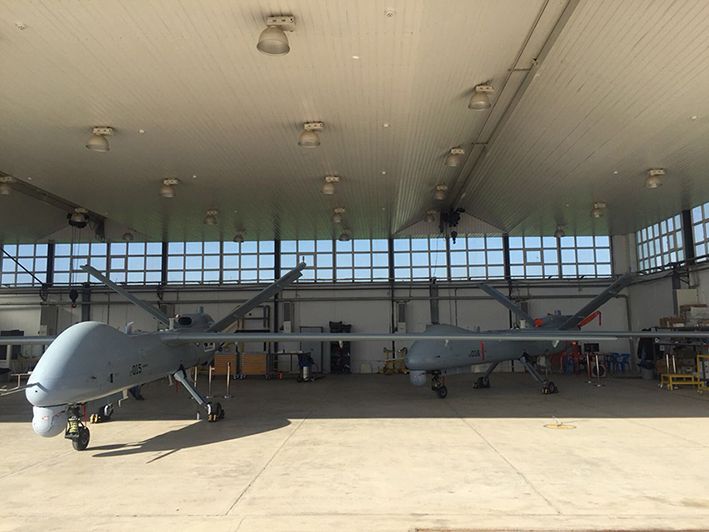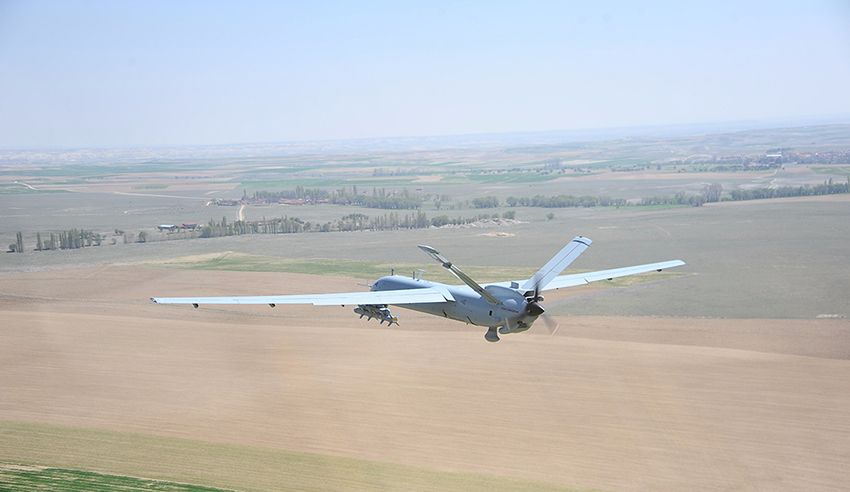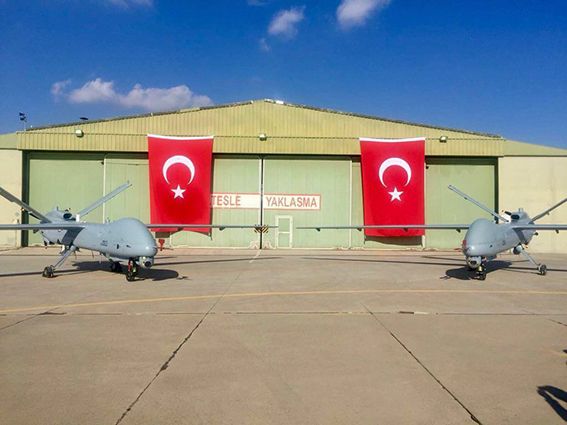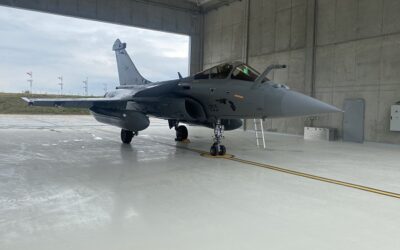TAI ANKA MALE UAS/RPA in the Spotlight
Designed, developed and produced by Turkish Aerospace Industries (TAI) under the Turkish UAV Development (TIHA/TUAV) Project, the ANKA (Phoenix) is a combat-proven Medium Altitude Long Endurance (MALE) UAS. Successfully deployed by the Turkish Armed Forces (TAF) during Operation Olive Branch, the ANKA UAS family has proven its capability to fly even in GPS denial conditions, and currently consists of five different aircraft models; ANKA Block-A, ANKA Block-B, Armed ANKA, ANKA-S and ANKA-I.
The ANKA Block-A version conducted its first flight on 30 December 2010 and achieved Initial Operational Capability (IOC) during the acceptance test campaign, which ended in late January 2013, using ANKA UAS prototypes 11-003 and 12-005. The formal acceptance certificate for the ANKA Block-A was signed by the Undersecretariat for the Defence Industries (SSM) and the Turkish Air Force (TurAF) on 1 February 2013. Equipped with Aselsan’s AselFLIR-300T FLIR payload, the platform has an endurance of more than 18hrs and an operating altitude of over 23,000ft: during a flight test performed on 16 September 2012 an ANKA Block-A prototype climbed to 25,600 feet.
ANKA Block-A has a 17.3m wingspan, is 8m long, 3.4m high and has a 1,750kg maximum take-off weight. Made up of around 7,000 parts, 261 units and 74 groups of 2,500 cables measuring over 3.5km in length, ANKA Block-A has been configured to carry payloads of more than 200kg (100kg under each wing), while carrying 400l (around 330kg) of JP-8 fuel that provides for 18 hours in the air.
Able to cruise at a speed of 80-110kts, the Block-A can operate at a distance of up to 200km, using an existing Ku-band line-of-sight (LoS) data-link system developed locally by Savronik. Designated GOZCU-II by the TurAF and deployed at the 14th UAS Base Command located in Batman Air Base for field tests in June 2013, an ANKA Block-A prototype (13-005) amassed a total of 179 flight hours during 67 sorties. The airframe crashed, however, while attempting to land on 3 December 2013 due to a technical failure.
Two ANKA Blok-As were deployed, with the required ground segment elements, at the request of Turkish Gendarmerie General Command at Elazig in January 2016 and the first operational flight was successfully conducted on 5 February. Serial numbers 11-003 and 12-004 (deployed on 25 March 2016) carried out more than 100 sorties within a six month period, though the first of them experienced a crash landing on 9 October 9 the same year. TAI supports ANKA Block-A flights under a leasing agreement signed with the SSM.
Meanwhile, TAI has modified one of the Block-A prototypes into an Armed UAV (SIHA) and has integrated Roketsan’s 2.75in semi-active laser-guided CIRIT (Jereed) air-to-ground munition. At 1.9m in length and weighing 15kg, the CIRIT has an 8km range and can be launched from either manned or unmanned aerial vehicles or ground and naval platforms. Armed with a 3kg warhead, able to penetrate 250mm of armour, the CIRIT can be fired either from a Smart Launcher (designed by Roketsan) or from a standard pod, in twin or quad launcher configuration. Each Smart Launcher weighs some 55kg in a 2-cell configuration and 110kg in a 4-cell, both figures including the munition. The ANKA-A SIHA conducted its first live firing test in May 2013 and qualification tests followed in October. However, the ANKA SIHA based on an ANKA Block-A aircraft and armed with a pair of CIRIT launchers under each wing did not enter service.
The ANKA Block-B, an upgraded and lightened version of Block-A aircraft, has better performance and is equipped with the indigenously-developed Aselsan SARPER synthetic aperture radar (SAR), in addition to the AselFLIR-300T FLIR payload. The ANKA Block-B, which is 160kg lighter than the first ANKA prototype and 100kg lighter than the Block-A aircraft, has a flight ceiling of 30,000ft and an endurance of 24hrs, thanks to its increased JP-8 fuel capacity of 530l (around 445kg) compared with 400l on the Block-A. Various modifications have been performed on the air vehicle to save weight. For example, the replacement of metal landing gears with composite ones provided a 25kg weight saving, which translates to an additional hour’s endurance. According to the Thielert CENTURION 2.0 engine product brochure, at cruise speed the JP-8 fuel consumption rate is 18-22l/hr, dependent on altitude, speed and payload. ANKA Block-B made its first flight in January 2015 and successfully completed acceptance/qualification tests 14 October 2016 at Sivrihisar Airport Base Command, under the supervision of SSM’s Acceptance Committee. The accepted aircraft in Blok-B configuration features a winglet due to the requirement of an additional 240kg in payload and 24 hours of endurance. This feature does not carry through to serial production aircraft because, following comprehensive analysis, it was discovered that the performance improvement did not outweigh the weight penalty.
Two (and three optional) ANKA Blok-B UAV Systems (with three air vehicles in each) have been ordered for the Turkish National Police (EGM) Directorate of Aviation and one system with three air vehicles for the MIT/Presidency. The EGM’s air vehicles will carry Aselsan’s CATS HD EO/IR Reconnaissance, Surveillance and Targeting System and Wide Area Surveillance System (to be deployed in an 18in stabilised turret), which is being developed by ESEN System. Turkish Gendarmerie General Command also operates at least six ANKA UAVs (probably a mixed fleet of Block-A, Block-B and at least two armed ANKAs), deployed from the old runaway of Elazig Airport and operated by Elazig Tactical UAV Unit Command. TAI supports the Command’s ANKA UAV operations under a leasing contract signed with the SSM.
On 1 April 2018, SSM used Twitter to announce that the ANKA Blok-B is in service with Turkish Naval Forces Command (TNFC). According to official sources, one Block-B system, consisting of three air vehicles, payloads and related ground segment systems, was leased by the SSM. Speaking to MT at the SAVTEK 2018 Defence Technologies Days Conference held at Istanbul Technical University (ITÜ) on 7 May this year, TAI ANKA-B Project Technical Manager Yener Çetin revealed that the leasing contract is a long-term one, with two air vehicles in service at the time and a third to be delivered soon.

The first two Block-B airframes are equipped with L3 Wescam CMX-15D FLIR payloads, but the third will also have the Aselsan SARPER radar. Since Aselsan’s CATS FLIR payload is not yet ready for operational use and FLIR Systems’ StarSAFIRE 380-HLD could not be procured due to ITAR regulations, TNFC has preferred the Wescam solution. The CMX-15D weighs in at 51.4kg against the 110kg of the AselFLIR-300T and 59kg for CATS. Deployed at Dalaman Naval Airbase, the ANKA Block-B conducted its first operational flight on 27 March this year, over the Aegean. According to the leasing contract, TAI and TUSAS Engine Industries’ (TEI) personnel deployed at Dalaman are responsible only for flight (take off, flight and landing) and maintenance services, while the payload is fully under the control of TNFC personnel.
According to Mr. Çetin, thanks to its long endurance and relay mode capability, the ANKA Block-B is able to cover the whole of the Aegean in a single sortie. The Block-B can operate at a distance of up to 250km with line-of-sight (LoS) communications. Thanks to its GMTI and ISAR modes, supporting both maritime and land surveillance, the 80kg SARPER SAR payload (100kg with radome) provides high resolution imagery even in cloudy conditions, at a stand off range of up to 40km, and ISAR imagery in the Maritime Surveillance Radar mode up to 70 kilometres. TNFC is planning to procure up to 12 ANKAs, either in Block-B or in Block-S (according to ÇETIN negotiations for ANKA-S is on-going) configuration, to be equipped with a FLIR and the SARPER SAR payloads, as well as a further 10 BAYRAKTAR TB2-S armed UAVs. Negotiations for the ANKA-S were apparently continuing at the time of writing.
Mr. Çetin also provided information on the technical features of the ANKA Block-B, Block-S and ANKA-I. With a service ceiling of 30.000ft, the platform has an endurance of 18hrs at 23,000ft mission altitude and 24hrs at 20.000 feet. All three have a 17.5m wingspan, are 8.6m long, 3.25m in height and have a 1,700kg take-off weight. They can operate at distances of up to 250km, using LoS data-links. Payload volume for all is 720l, and payload capacity 250 kilogrammes. Mr. Çetin underlined that, as of May 2018, the ANKA fleet has amassed a total of 5,000 operational flight hours, including those conducted during Operation “Olive Branch”. Thanks to its GPS-free flight capability, EMI/EMC protection, national encrypted data communication capability, radar-based take-off and landing capability in GPS-denied conditions and directional data link antenna, ANKA was the only UAV system in the Turkish Armed and Security Forces’ inventory able to prosecute missions during Operation “Olive Branch” in a hostile electromagnetic environment. ANKA can be readied for flight by just three personnel in 45 minutes. Having started in 2017, TAI produces two ANKA UAVs per month.
Meanwhile, TAI has developed a new version of the armed ANKA (SIHA), based on the Block-B air vehicle, making its maiden flight on 7 March 2017. Armed with a total of four Roketsan MAM-L semi-active laser-guided air-to-ground smart munitions (two under each wing) and equipped with Aselsan’s CATS FLIR payload, an armed ANKA-B carried out its first firing test on 28 April 28 of the same year.

Following its entrance into Turkish Gendarmerie General Command service under a leasing contract, armed ANKA Block-Bs conducted their initial air strikes against PKK terrorists in early July 2017 in the Bingol, inflicting five terrorist casualties with three MAM-Ls. With an increased payload capacity, the ANKA-B SIHA can carry 2 UMTAS-L ATGMs, 4 CIRIT missiles, 4 MAM-L or 8 MAM-C missiles in a single sortie. Mr. Çetin underlined that efforts for the integration of Roketsan’s TEBER-81 (345lb) and TEBER-82 (595lb) INS/GPS+Laser-guided smart bombs are currently ongoing. Each UMTAS-L ATGM weighs 35kg, CIRIT weighs 15kg (17.5kg with canister), a MAM-L munition weighs 22kg and MAM-C 8.5 kilogrammes.
On 2 February 2018, SSM announced that acceptance of the first ANKA-S UAV system had been completed successfully, and the aircraft handed over to the TurAF. Having achieved its maiden flight in September 2016, the first ANKA-S system consists of two air vehicles, FLIR payloads, a satellite communications (satcom) capability and related ground systems. SSM underlined the fact that the ANKA-S would be used for reconnaissance and surveillance missions and that its satcom capability means that up to six aircraft can be controlled simultaneously via satellite: initially first stage via the TurkSat 4B [Ku-band, with 10mb/s data transfer rate] and later via the TurkSat 6A (X-band) when it becomes operational in 2021. The ANKA-S air vehicle is based on the Block-B configuration, with around 300 enhancements to meet TurAF requirements. In addition to the satcom communication capability, it is equipped with a national IFF System (Mode 4 and Mode S), indigenous flight and mission computers and a personnel locator system. In addition, ANKA-S also integrates two MXF-484 HAVE QUICK radio sets for encrypted air-to-air and air-to-ground communications and can be used in the radio relay mode. An ANKA-S Operation, Simulator ad Training Centre [OSEM]) has been established at Eskisehir.
According to images published on the SSM’s social media account, the first two ANKA-S are equipped with FLIR Systems’ StarSAFIRE 380-HLD FLIR payloads rather than Aselsan’s CATS FLIR. In March and April this year, SSM revealed that TAI has delivered a further four air vehicles, to the TurAF, bringing the service’s current total to six.
On 25 October 2013, TAI was awarded a US$290 million contract by the SSM to deliver 3 ANKA-S systems with 10 aircraft (2+4+4), 12 ground control stations and sufficient radar-based automatic take-off and landing systems to allow deployment to two separate air bases to meet TurAF’s requirements. Aselsan’s share of the contract, delivering 10 CATS FLIR payloads and some avionics including INS/GPS and radio systems is valued at $33.6 million and deliveries are expected to be completed in 2018. TAI will manufacture a total of 11 ANKA-S UAVs and deliver 10 of them to TurAF. Official sources indicate that TurAf’s ANKA-S are currently deployed with an ANKA-S squadron located at 14th UAS Base Command in Batman Air Base, but that a second ANKA-S squadron is planned in near future.
On 24 March 2018, the SIGINT version of ANKA Block-B, dubbed ANKA-I, was revealed when two in-flight photographs of it were uploaded to social media sites by the SSM, although though the agency quickly deleted them. The ANKA-I is a heavily modified version of the Block-B and is equipped with ESM/ELINT and COMINT/DF systems (made by Aselsan and Ultra Electronics) for SIGINT missions. However, it lacks the SATCOM capability of the ANKA-S variant. ANKA-I has a total of 14 different aerials around the fuselage, primarily on the underside and most likely for COMINT missions. There are four sensor panels on a large cheek fairing on the starboard side of the forward fuselage, which are probably for ESM and ELINT functions.
Contrary to expectation (FLIR Systems’ StarSAFIRE 380-HLD had been anticipated), there is no FLIR payload on the first ANKA-I air vehicle, whereas a sensor turret (probably for the ESM mission) is mounted under the nose. Under the main fuselage, a pylon contains directional antenna of the airborne data terminal for Savronik’s Ku-Band LoS data link system. The photographs show that ANKA-I is fitted with an air data probe on the nose, indicating that they were probably taken during initial flight testing. According to ÇETIN, the ANKA-I conducted its maiden flight in October 2017 and acceptance testing was carried out in early May 2018. Under a contract awarded in March 2016, Milli Istihbarat Teskilati (MIT – National Intelligence Agency, which reports directly to the Presidency since 2017) will receive one ANKA-I SIGINT system comprising three aircraft. At least one of the air vehicles is expected to be equipped with a FLIR payload in addition to its SIGINT mission equipment. In a stock exchange statement made by Aselsan on 7 April, it was revealed that the company has secured a $8.964 million contract from TAI and that deliveries under the contract were due to take place in 2016-2017.
As of 8 May 2018 there are around 20 ANKA UAVs operating from at least three different bases, including six ANKA-S in TurAF service deployed at Batman Air Base, 2+1 ANKA Block-Bs deployed at TNFC Dalaman Naval Air Base under a lease contract, 1+2 ANKA-I in MIT service, with one ANKA Block-A, three ANKA Block-Bs and at least two ANKA-B SIHAs deployed at Elazig Airport serving with Turkish Gendarmerie General Command under a lease contract. In addition, six ANKA Block-Bs have been ordered for the Turkish National Police (EGM) Directorate of Aviation Office. As of May 2017, TAI is producing two ANKA UAVs per month.
Under the contact signed by TAI and TEI on 31 October 2014, TEI will deliver two prototypes and ten series production PD-155 engines for the TurAF ANKA-S fleet. Mr. Çetin underlined that during flight tests the PD-155 engine has provided better performance than the Thielert CENTURION 2.0S (CD-155) engine which currently powers ANKA UAVs.
On 26 April 2018, TEI General Manager Mahmut Aksit disclosed that the company delivered nine PD-155 engines to TAI in 2017, as well as a PD-170 prototype for ground and air tests in November. The first flight of the latter, which can operate at up to 40,000ft, onboard an ANKA-S is expected to take place in mid 2018.

Ibrahim Sünnetci
























